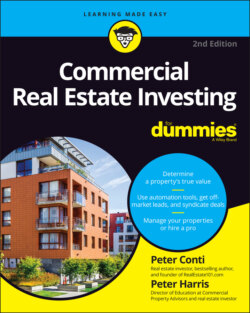Читать книгу Commercial Real Estate Investing For Dummies - Peter Harris - Страница 51
How the Commercial Property Evaluator Works
ОглавлениеYou can make copies of the Commercial Property Evaluator (as seen in figure 3-1) and fill in the blanks to use some algorithms we’ve developed over the years to tell you the estimated property value.
The online version provides even more information, telling you:
If the deal is worth pursuingAn appropriate purchase priceA suggested initial offer price
The Commercial Property Evaluator helps you determine whether a deal is worth pursuing by comparing the actual value to the asking price. If the property is way overpriced, the online version provides a red light telling you not to waste your time. A yellow light indicates maybe there’s a deal here. When you see a green light, that means go! You’ve come across a great deal and need to move quickly to get it before someone else does.
Here’s the data you need to enter into the Commercial Property Evaluator:
The number of units
The asking price
The unit mix (how many studios, one-bed, and two-bed units)
The average rent per unit type
We’re keeping this super simple, so the Commercial Property Evaluator is for apartment buildings only, got it? While the quick valuation provided by the Commercial Property Evaluator isn’t perfect for every situation, we’ve found that it’s close enough to help you sort deals into red, yellow, and green light piles so that you can avoid the biggest mistake that most new commercial investors make, like getting stuck over analyzing properties and never making any offers. Here’s what you can ignore when using the Commercial Property Evaluator:
The claimed expenses (because they are highly suspect)
The cap rate shown in the listing (since it’s not likely to be accurate)
Any “proforma” information (which includes projected claims about future income)
FIGURE 3-1: The Commercial Property Evaluator is a tool that helps you evaluate a property’s worth. It’s available on CommercialQuickStart.com.
Because cap rates are higher or lower depending where you are investing, and can change over time, you can adjust the cap rate you prefer to use in your market. Any good commercial broker can help you determine which cap rate to use for your market. After you decide on this, make sure to use the same cap rate to value every property in the same class. You can fill in the cap rates for your market in Table 3-1.
TABLE 3-1: Cap Rates
| Property Class | Typical Cap Rate | Cap Rate for Your Market |
|---|---|---|
| Class A | 3.5 to 4.5 | |
| Class B | 5.0 to 6.0 | |
| Class C | 6.5 to 7.5 |
Try out using the Commercial Property Evaluator and get the free Masterclass by going to CommercialQuickStart.com.
The Commercial Property Evaluator will determine the leased up, stabilized value of the property for you using the following default settings, which is what we are currently using for most Class C apartment buildings:
5% vacancy
45% expenses
.07 cap rate
If you’d like a look under the hood, Table 3-2 displays the formulas used by the Commercial Property Evaluator along with some actual numbers from the 50 unit “Courtside Apartments” so you can see how this works.
TABLE 3-2: Courtside Apartments Example
| Step | Description | Courtside Apartments | Shortcut to Next Step |
|---|---|---|---|
| One | Total Monthly Income | $80,000 | Get Annual Income (Multiply × 12) |
| Two | Total Annual Income | $960,000 | Remove 5% Vacancies (Multiply × .95) |
| Three | Effective Gross Income | $912,000 | Remove 45% Expenses (Multiply × .55) |
| Four | Net Operating Income (NOI) | $501,600 | Apply Cap Rate (Divide by .07) |
| Five | Property Value | $7,165,714 |
Using the online version our mentoring clients also enter the market rents to come up with a “Proforma” value so we know what the property will be worth when we increase the rents up to market value. To do this yourself with the Commercial Property Evaluator here in the book, take an extra step and enter the market rents instead of the actual rents. This will give you the proforma value of the property.
We then compare these three values to give us an indication of what the upside looks like and whether it’s worth our time to pursue the deal:
Asking price from the seller
Actual property value
Proforma value
You can use the Commercial Property Evaluator to quickly separate deals into three piles so that you don’t waste your time on properties where the seller is simply asking way too much for the property. In most cases this is a pretty good clue that they aren’t motivated. They’re hoping that someone comes along who’s willing to pay more for the property than it’s actually worth.
Because we’re calculating the leased-up stabilized value of the property using a 5 percent vacancy rate, you’ll obviously have to make further adjustments with a property that has a high vacancy rate or that needs to have rehab work done.
